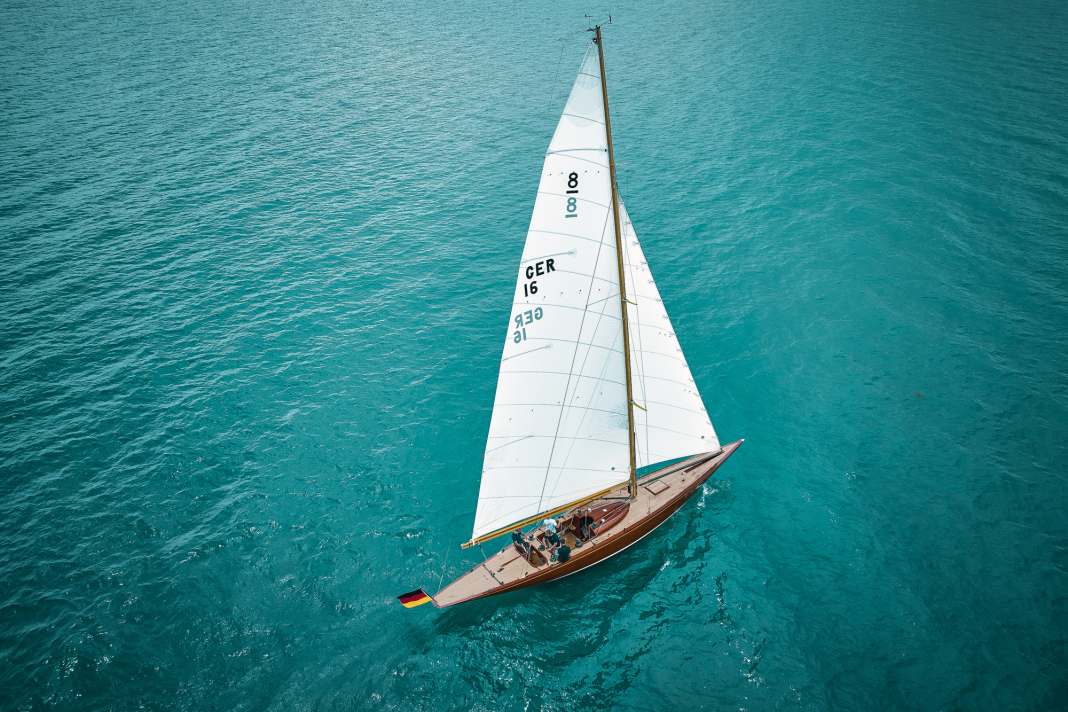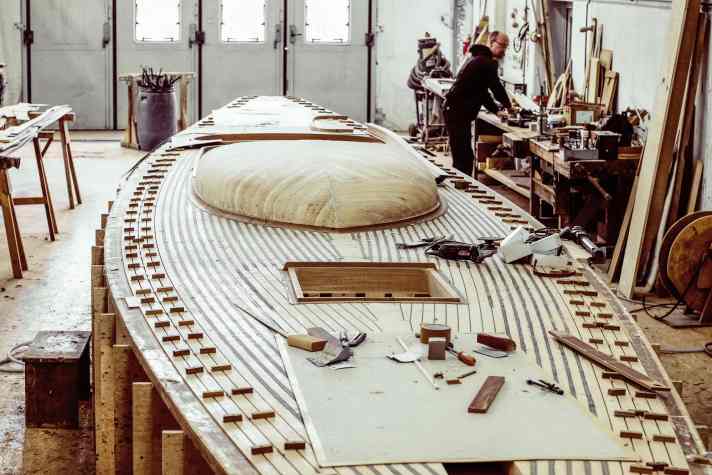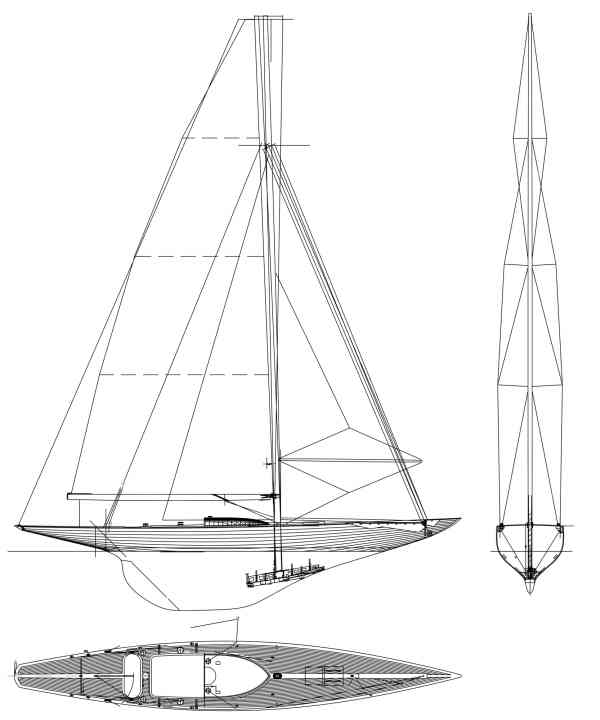Third-Rule-Eight: "Starling Burgess" - unusual new construction of a mysterious design






The water sparkles bright green under the stern of a classic 8-metre racing yacht made of glossy varnished Khaya mahogany in Langenargen harbour. Her name can be read in gold letters in mirror writing on the surface below: "Starling Burgess".
The homage to the yacht designer is pure understatement. What is afloat here is a total work of art created by many of those involved, who recently built the traditional aft in record time under the direction of master boat builder Josef Martin and his son Sven at their shipyard in Radolfzell. Based on a design from Burgess' pen that dates back to 1937 but was never realised.
The "Starling Burgess" is very similar to the legendary "Iskareen"
Juliane Hempel explains how the story began. The professional involvement with metre-class yachts has been a feature of the designer's professional life since her engineering studies. In her search for the secret of fast designs, she began comparing the VPP data of the most successful yachts in history many years ago. She was particularly fond of "Iskareen". The boat from 1939, which Olin Stephens himself described as his favourite eight, is regarded as the pinnacle of development in its time.
"One day, a customer wanted a fast figure of eight," says Hempel, recounting how she resumed her investigations at the time and once again ended up with "Iskareen" as the crown of creation. But a replica is not possible because licence negotiations over the design plans fail. In an exchange with the head of the technical committee of the eights, John Lammerts van Bueren, Hempel comes across a 1937 drawing for an aluminium eighth that is very similar to "Iskareen" in the Starling-Burgess biography "No Ordinary Being". However, as aluminium was not permitted at the time, it was never built.
The secret of Burgess' aluminium design
As an eccentric mind, Burgess was known for such escapades. Artist, inventor and designer at the same time, he also designed cars and aeroplanes. But what this crack was all about remains a mystery in yachting history. "Nobody knows why it was created; as an aluminium flush decker, it didn't conform to the rules at all," says Hempel.

However, they only realised the real secret after they had greatly enlarged the drawings. They were strikingly similar to "Iskareen" in the crucial details. The answer may have something to do with the fact that Stephens, who designed "Iskareen" two years later, was working in Burgess' office at the time.
Van Bueren, who had been President of the Aft for many years, used his overseas contacts and found the plans for the ominous Burgess design in a small museum. "There were three drawings of the ship. A sail plan, the line plan and a general plan. And my client was able to acquire these along with the building licence," says Hempel.
Each individual plank was designed on the computer
Hempel redesigned the stern on the computer based on the old drawings. The shipyard received all the plans and data sets for each of the planks tapering towards the ends of the ship in 3D and for the steel frames and ribs, including their forging angles and the drill holes for the planks. Hempel also designed each individual slat of the moulded frames on the computer, so that after cutting and gluing they resulted in precisely fitting components.
The engineer was able to draw on the experience she gained during the development of the 75er Schärenkreuzers "Gustaf" had collected. It was built in the same way, with one major difference: "The special thing about the aft was that I had to completely redimension the construction in accordance with the building regulations," says Hempel, as the dimensions were designed for aluminium construction.
The superstructure proved to be another challenge. The original plan did not provide for one. The client wanted the minimum dimensions and the roundest possible shape. The result was a cap made of seven layers of steamed wood, glued together in a mould, which does not show how many hours have gone into it.
The deck and hull of the "Starling Burgess" were built in parallel
With the approval of the class association and under the supervision of the surveyor, the keel will be laid in Josef Martin's shipyard in March 2020. The designer has supplied the cross-sections for the keel, stem and sternpost, which the boatbuilders work out by hand from the solid wood using templates. Once they have erected the steel frames and attached the model stringers, the glued frames are placed in the scaffolding and it is planked up.

"Meanwhile, the deck was being built next to the hull," explains Josef Martin's son Sven. He is sitting at the helm of the eighth, which he has just steered out of the narrow harbour basin. His boatbuilding colleagues Axel Rössle and Moritz Eider are also on board. Sven Martin led the team when the boat was built in record time. Towards the end of the summer after the keel was laid, "Starling Burgess" successfully took to the regatta course for the first time.
The short construction time was possible because the shipyard team was able to draw on its experience in building the "Gustaf" skerry cruiser, which was built using the same construction method. However: "We have never built the hull and deck separately before," says Axel Rössle. "But it was relatively easy because the drawings were good. Very precise. And because the metalworker did good preparatory work. Everything was very true to size. This made it easy to bring the two parts together afterwards."
Sparse interior in regatta mode
When the towing connection is released - the small diesel engine is removed in regatta mode - Rössle and Eider hoist the sails on the spruce mast. It is a dull day, the sun is fighting against a thick blanket of cloud. The wind is moderate, the maxi indicator on the mast shows it at seven knots. And yet the aft picks up speed remarkably quickly and is soon travelling at a constant six to seven knots with a slight shift in the sheets on the wind.
The high-strength, almost empty hull resounds like the resonance box of a musical instrument when winches whirl, stretchers whirr and clamps click. Below deck, only the prescribed minimum interior has been installed. Two berths - without cushions - a locker, floorboards. In the centre is the mast foot, which can be moved forwards and backwards under load when sailing - on two inconspicuous cords in the cockpit.
The cockpit is also designed for racing. The helmsman stands aft in a separate opening on the floorboards, while there are only two small folding stools on the side of the boat for the crew in the cockpit forward.
Except for the fittings, the boat builders say, the deck was completed lying alongside the ship, parallel to the hull. In a sporting battle against time. "We built a substructure from temporary beams, into which the deck beams were embedded," explains Axel Rössle.
"Starling Burgess" is a boat for hard, fast regatta sailing
After the actual deck was laid on the deck beams, a stave deck made of Oregon Pine was laid on top, and then the superstructure was started. It is just as unusual for a classic aft as the recess in the foredeck for the spinnaker pole. This was a request from the racing crew, who were involved in the construction phase to help design the deck layout. The recessed winches, for example, are also a result of this collaboration.
"This has become a very serious sport," says Juliane Hempel, describing the process. "Eightsailors are no longer just interested in the beautiful boats and the lifestyle surrounding them. There are high-calibre crews and a lot of ambition involved, and the sailing is tough and professional."
The 8-mR yacht "Starling Burgess" was conceived decades ago for precisely this purpose. And Josef Martin's shipyard has skilfully given shape to this spirit. A masterpiece. And, as Juliane Hempel, who unlocked the secret of the design, summarises: "The boat is really fast!"
Technical data "Starling Burgess"
8-mR yacht based on a Burgess design from 1937

- Building yard: Joseph Martin
- Construction:Juliane Hempel
- Torso length: 15,12 m
- Waterline length:9,42 m
- Width: 2,44 m
- Depth: 1,99 m
- Displacement: 8,65 t
- sail area: 81 square metres
- Shipyard Josef Martin: www.martin-yachten.de
- Designer Juliane Hempel: www.hempel-design.com

